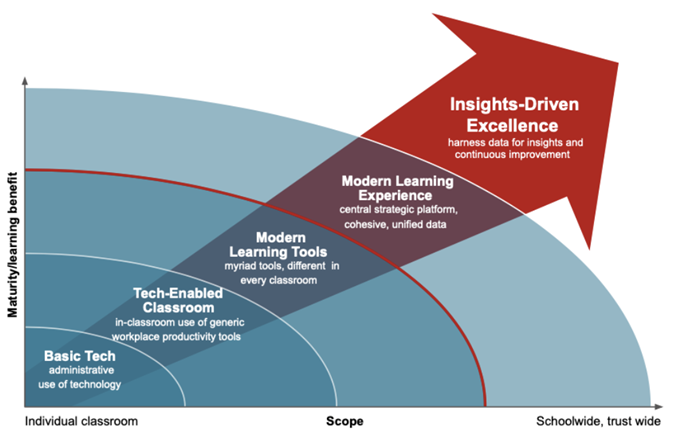More times than we’d care to count, we’ve seen individuals and organisations promise to revolutionise education through the latest gadget, piece of software, administrative process or teaching method.
While many seem promising, few have delivered this transformation. This isn’t surprising: tools alone cannot bring human change. Educational change is human change and needs to be led by humans, not technology.
Having said that, however, there is a revolution happening in education. A slow one, but a revolution nonetheless. This shift in education is captured eloquently by Grant Lichtman, in his book Moving the Rock: 7 Levers We Can Press to Transform Education:
“Deeper learning is better than shallow, student-centric learning is better than teacher-centric classrooms, questions and curiosity are more important than rote answers, understanding and wisdom are more important than mere knowledge.”

So what does this look like in the classroom? It’s personalised learning, and teachers adapting to the individual needs of students. It’s project-based learning, with cross-disciplinary, authentic, real-world experiences. It’s ensuring learning does not end in the classroom but is carried home with students and parents. It’s proactively using data to ensure individualized and continuous improvement, rather than just waiting for an end of term report.
These activities can only be made possible by an enabling school environment. Policies, tools and processes need to all support teachers to provide this experience to students. More often than not, however, schools have been feeling pressure to deliver this new learning experience while being constrained by traditional edtech tools created in the old learning paradigm.
There have been some edtech products that have been keeping up with this educational revolution. These new edtech platforms go beyond simply addressing specific educational needs, but instead provide a comprehensive Modern Learning Experience. Mirroring this educational revolution there are 6 ways in which modern and effective edtech are transforming to allow for better, authentic, student-centred learning.
Tactical one-point to Strategic school wide
Traditional edtech tools addressed specific educational needs. Often teachers from different subjects would use different tools. Both students and teachers would have to learn how to use several different products, which not only was cumbersome but also made cross-disciplinary work difficult.
Modern platforms, however, now provide teachers and students with a holistic and unified experience. This means they are connected in a space where collaboration and sharing of resources is possible, is flexible and works for their subject, and leaders can have a single bird’s eye view of student performance.
Transaction-Centric to Engagement-Centric
In the past, education and traditional edtech have been centred around measuring progress against specific key tasks, at fixed points in time. This resulted in periodic and summative check-ins with students, which does not match the dynamic and messy nature of learning, inhibits collaboration and focuses on achievement rather than progression.
Instead, the Modern Learning Experience focuses more on the whole journey of the student, including continuous feedback and collaboration between teacher, student and parent. Conversations between these parties are around improvement and looking forward, rather than what the student has failed to achieve. Parents have a clearer picture of their child’s challenges and achievements. Teachers can proactively provide just-in-time support. Students no longer have to wait for the end of the year to understand their performance.
Cookie-cutter to Adaptable
Just as we want our students to be more independently driven, we must be able to allow our teachers to set their own path, and provide them with the tools they need. Traditional edtech failed to deliver this level of adaptability to the teachers. Teachers instead were meant to change their teaching methods and schedules to conform to the tools provided for them. This stifles both teacher and student creativity and has made technology a hurdle rather than an enabler.
A successful Modern Learning Experience provides teachers with the freedom to innovate and adapt in response to their students’ needs, rather than the technology’s requirements. This allows schools to focus on effective pedagogy and practice that fits their own unique vision and culture, making innovation synonymous with better learning.
Complex to Intuitive
User interfaces have come leaps and bounds since the Dot-com era in the 90s. That said, edtech tools have taken a while to follow suit. Many of the traditional edtech tools are frustratingly difficult to use, causing teachers to work for the technology rather than the opposite.
More modern tools require minimal training and are designed to be intuitive, allowing teachers to not only use technology but forget it’s even there. The invisibility of modern edtech allows the teacher’s time to be spent teaching, and their professional development time to be spent on actual pedagogy rather than how to use outdated and cumbersome tech tools.
Flying blind to Data-driven
Unifying the learning experience, and all the data surrounding teachers and students has allowed school leaders to gain a holistic understanding of school and student performance. It allows them to identify and support struggling teachers, and empower those that are ready to lead. Previously, fragmented technology meant that such visibility was impossible; school leaders had to work on what they believed, but can now have an unprecedented amount of data from which to make decisions.
Unknown data governance to fully governed data
Separate tech tools meant that not only was data not properly used, but it was also unmanaged. Whereas before there was a lack of clarity around how data was being used (without consuming time and resources), modern tools can (and should) provide clarity around student data management, allowing schools to become GDPR compliant without additional hassle.
While the education revolution is still underway, there are examples of edtech tools that are not just following this revolution but working actively to empower it.
To find out how schools are setting out to achieve the modern learning experience, One Poll recently conducted a study. Download it here to understand how and why leading schools make a strategic change and what factors they considered.

